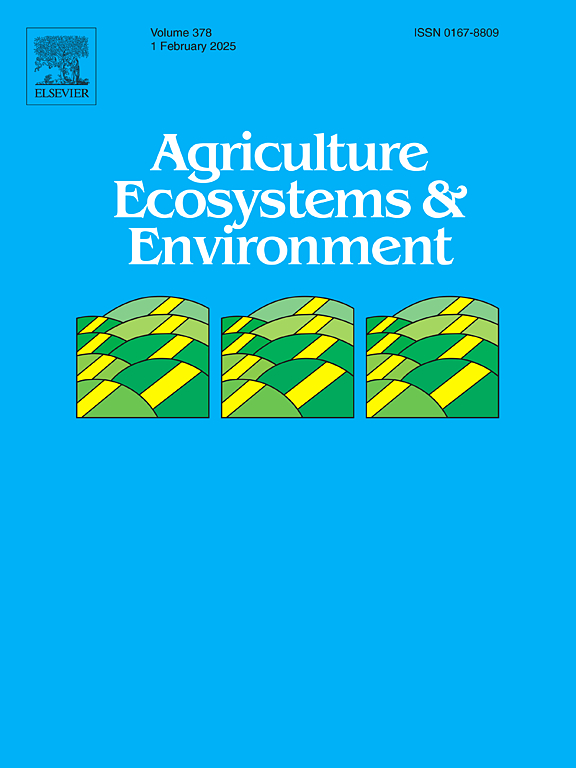Rare rather than abundant phoD-harboring bacteria shape soil phosphorus bioavailability in karst orchard–medicinal plant intercropping systems
IF 6.4
1区 农林科学
Q1 AGRICULTURE, MULTIDISCIPLINARY
引用次数: 0
Abstract
Cultivating medicinal plants in orchards has emerged as a promising strategy to improve soil nutrient profiles, utilize under-tree space effectively, and boost farmers’ incomes. However, the mechanisms influencing soil phosphorus (P) bioavailability in orchard–medicinal plant intercropping systems (OMIs) remain unclear, particularly in karst regions where P is severely deficient, and intercropping effects vary by medicinal plant species. This study assessed the short-term effects of medicinal plant intercropping on soil P bioavailability in four OMIs (Prunus. salicina + Hypericum monogynum [PH], P. salicina + Polygala fallax [PP], P. salicina + Rubus suavissmus, and P. salicina + Semiliquidambar cathayensis + Illicium difengpi) in the karst region of the Lijiang River Basin, Southwest China, with P. salicina monoculture (Pm) as a control. Compared with Pm, OMIs generally reduced soil bioavailable P fractions, except CaCl2-P, while increasing microbial biomass P, potentially enhancing temporary organic P (Po) reserves. These changes supported plant inorganic P (Pi) uptake from the rhizosphere soil, as shown by shifts in P activation, supply capacity, and acquisition strategies. Furthermore, OMIs significantly altered the composition and structure, though not the diversity, of phoD-harboring bacterial communities. While abundant taxa (e.g., Bradyrhizobium) and rare taxa (e.g., Pseudomonas) responded differently to nutrient changes, rare taxa exhibited greater responsiveness, particularly in the PH and PP systems. Soil bioavailable P fractions were primarily regulated by rare phoD-harboring bacteria, influenced by soil N:P ratio, pH, and moisture. Overall, OMIs, particularly PH and PP, shifted P utilization strategies from Pi acquisition to temporary Po preservation, improving P-use efficiency through plant-specific impacts on rare phoD-harboring bacteria. These findings highlight the importance of selecting medicinal plants for optimizing P cycling and suggest that targeted P fertilization in OMIs could enhance karst soil productivity.
喀斯特果园-药用植物间作系统土壤磷生物有效性由稀有而非丰富的含磷细菌决定
在果园种植药用植物已成为改善土壤养分状况、有效利用树下空间和提高农民收入的一种有前途的策略。然而,影响果园-药用植物间作系统(OMIs)土壤磷(P)生物有效性的机制尚不清楚,特别是在磷严重缺乏的喀斯特地区,间作的效果因药用植物种类而异。本研究评估了药用植物间作对4个地区土壤磷生物有效性的短期影响。以单作水杨(Pm)为对照,研究了丽江流域喀斯特地区水杨+金丝桃(Hypericum monogynum) [PH]、水杨+黄菖蒲(Polygala fallax) [PP]、水杨+水菖蒲(Rubus suavissmus)和水杨+半水菖蒲+地风匹(Illicium difengpi)。与Pm相比,OMIs总体上降低了除CaCl2-P外的土壤生物有效磷组分,同时增加了微生物量P,可能增加了临时有机P (Po)储量。这些变化支持植物从根际土壤中吸收无机磷,表现为磷素激活、供应能力和获取策略的变化。此外,OMIs显著改变了phod细菌群落的组成和结构,但没有改变其多样性。虽然丰富的分类群(如缓生根瘤菌)和罕见的分类群(如假单胞菌)对营养变化的响应不同,但罕见的分类群表现出更大的响应,特别是在PH和PP系统中。土壤生物有效磷组分主要受稀有含磷细菌调控,受土壤氮磷比、pH和水分的影响。总体而言,OMIs,特别是PH和PP,将磷的利用策略从获取磷转变为暂时保存磷,通过对稀有磷载体细菌的植物特异性影响提高磷的利用效率。这些发现强调了选择药用植物对优化磷循环的重要性,并表明在OMIs中定向施磷可以提高喀斯特土壤生产力。
本文章由计算机程序翻译,如有差异,请以英文原文为准。
求助全文
约1分钟内获得全文
求助全文
来源期刊

Agriculture, Ecosystems & Environment
环境科学-环境科学
CiteScore
11.70
自引率
9.10%
发文量
392
审稿时长
26 days
期刊介绍:
Agriculture, Ecosystems and Environment publishes scientific articles dealing with the interface between agroecosystems and the natural environment, specifically how agriculture influences the environment and how changes in that environment impact agroecosystems. Preference is given to papers from experimental and observational research at the field, system or landscape level, from studies that enhance our understanding of processes using data-based biophysical modelling, and papers that bridge scientific disciplines and integrate knowledge. All papers should be placed in an international or wide comparative context.
 求助内容:
求助内容: 应助结果提醒方式:
应助结果提醒方式:


